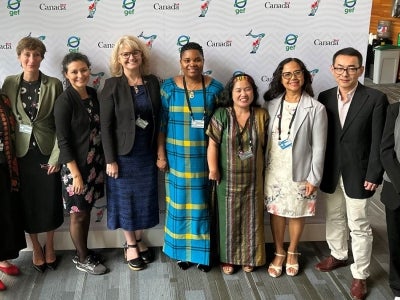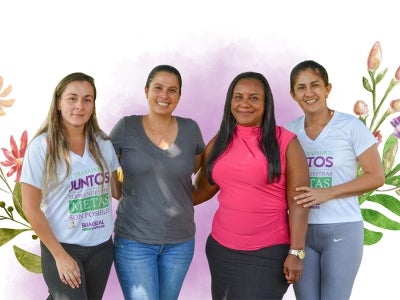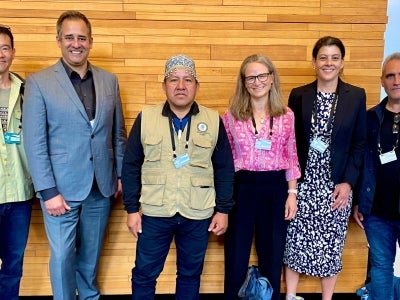
Woman harvesting hydroponics celery. Photo: Wytsnsr/Shutterstock.
We know that advancing gender equality is one of the systems changes needed to achieve environmental gains – in fact, it is shown to be a driver of progress across many Sustainable Development Goals - but there is a lack of data and evidence about what works to succeed in this complex area.
UNDP has steadily been building an evidence base in this area from results reported annually by its portfolio of projects with grant financing from the Global Environment Facility (GEF). UNDP is one of the largest implementing partners of the GEF and supports countries across five interrelated areas: (a) sustainable management of biodiversity and ecosystems; (b) sustainable, affordable and accessible energy services; (c) scaling up climate change adaptation and mitigation; (d) sustainable management of chemicals and waste; and (e) improved water and ocean governance.
GEF has additional monitoring requirements beyond UNDP’s that include annual reports monitoring progress against project-level outcomes. UNDP includes specific questions to track and measure project-level results in advancing gender equality and women’s empowerment. We report on these results in our annual performance report; the tenth such report has just been released.
We know from this project-level reporting that, overall, 86% of UNDP’s portfolio of GEF-financed projects under implementation are mainstreaming gender and advancing gender equality.
GenderBlog1.JPG
Let’s look at five things we learned from the portfolio in 2017 and what’s working at the project-level to advance gender equality in the context of environmental and resilience focused work.
1) Gender targets can be an effective way to ensure women’s role in natural resource management at the project-level.
In rural settings women are highly dependent on natural resources– indeed, women are most often the primary providers of water, food and energy at the household and community level – yet they are often excluded from local and national environmental governing bodies, such as land and water use committees. Many projects in the UNDP-GEF portfolio set specific targets or requirements for women in decision-making roles, such as in Zambia where work to regenerate indigenous forests in the country’s Central Province requires gender parity in local governance committees, including in executive positions that make decisions on selection and implementation of community-led activities for sustainable land management. Targets and quotas can not only help to advance women’s priorities in natural resource management, they can also challenge traditional gender norms that prevent women from taking on leadership roles. Overall, 69 projects in 73 countries in the UNDP-GEF portfolio in 2017 worked to ensure women’s leadership and decision-making in environmental management.
 Woman speaking. Photo: UNDP Lao PDR.
Woman speaking. Photo: UNDP Lao PDR.
2) Women’s groups are doing amazing things.
‘Strength in numbers’ is a cliché for good reason. Women’s collective groups are a powerful tool for gender equality, and can help advance and sustain environmental and resilience outcomes. Some groups work as savings and loans collectives to pool resources and share risk, especially important in places where women have low levels of land ownership and lack collateral to secure loans. Others are knowledge and solidarity networks where women can come together for trainings and support, critical for building resilience and capacity. The Gates Foundation notes that 75 million women are involved in self-help groups in India alone!
In the UNDP-GEF portfolio, 34 projects in 31 countries worked to strength self-help groups and other women-led community based organizations in 2017. Many projects support women’s producer groups, such as in Brazil where partnering with women’s cooperatives is a key strategy in shifting away from unsustainable agricultural practices to an approach that conserves biodiversity.
3) Sweat the small stuff.
Women contribute $10 trillion to the global economy in the form of unpaid care work. Water collection alone is, as UNICEF notes, “a colossal waste of time for women and girls” taking up a collective 200 million hours a day. Take the young woman in Myanmar my colleague Yusuke Taishi spoke with who travels ten times a day to the community pond to collect water for nine family members – imagine what else could she be doing with this time. Data from Uganda shows that having a water tap nearby decreases the time women spend on care work by up to two hours a day!
So ‘small’ measures such as solar-powered water tanks and multifunctional platforms, while also being environmentally-friendly, can have big impacts in terms of time-savings for women. For example, in Sierra Leone it was reported that new water facilities closer to home has meant more time for school-aged children in the project area to study for school and more time for women to engage in trading and small businesses; in Mota Ulun village of Timor-Leste, new water supply taps mean less time women need to spend on water collection which previously consisted of three or four 500 meter trips a day with a wheelbarrow.
 Woman tending to vegetables with a sleeping baby on her back. Photo: UNDP India.
Woman tending to vegetables with a sleeping baby on her back. Photo: UNDP India.
4) However, we must pay attention to the structural drivers of gender equality.
While on-the-ground measures are vital we must also tackle the upstream determinants of gender equality. Policies, processes, and institutions are often designed as gender neutral, though have different impacts on women and men. In 2017, eight projects in six countries worked to make specific national policies gender responsive. 21 projects in 17 countries and globally did capacity building work for national-level decision-makers to mainstream gender considerations into specific environment sectors. This works includes some promising progress to make policies and institutions gender responsive, such as in Brazil where gender considerations have been integrated into the draft State Policy to Combat Desertification, and work with UN Environment to train representatives from 47 Least Developed Countries to effectively negotiate gender and climate action into intergovernmental climate change processes.
While some national policies are not responsive to gender considerations, many are downright discriminatory. A UN Women study of 143 economies found that nearly 90% had at least one legal difference restricting women’s economic opportunities. Women’s land rights in much of the global south are particularly restricted - in developing countries, women make up only 10 to 20 per cent of land holders. In 2017, four projects in three countries reported work to improve land rights for women including in Burkina Faso, where women in rural communities now have their own plots of land to farm. This work is significant, but more projects should be paying attention to the upstream drivers of gender inequality and ensuring that policy-level work is gender responsive.
 Woman speaking at a meeting in Mali. Photo: UNDP Mali.
Woman speaking at a meeting in Mali. Photo: UNDP Mali.
5) There is a lot of exciting work to look forward to.
As we look ahead, there are promising and innovative results keep an eye on, like the “Yachaywasi Michawarmi” school in Peru that is being created with UNDP support and GEF financing to educate women as future practitioners and leaders of sustainable energy solutions for the country; broadening efforts to improve understanding of gender considerations in chemicals and waste management projects;
Project-level reporting for 2018 has already started and we are continuing to build our evidence base for advancing gender equality in the context of environmental and resilience focused work. Stay tuned!



